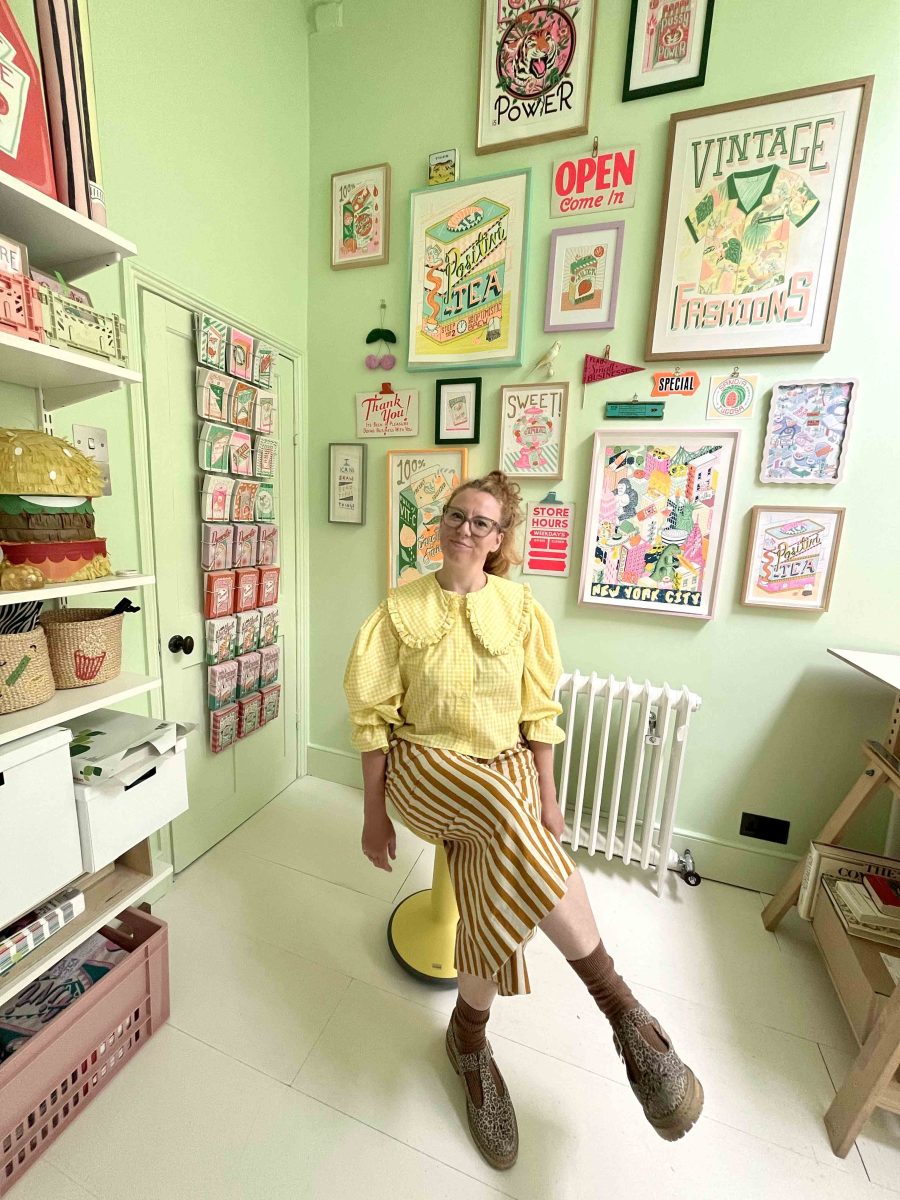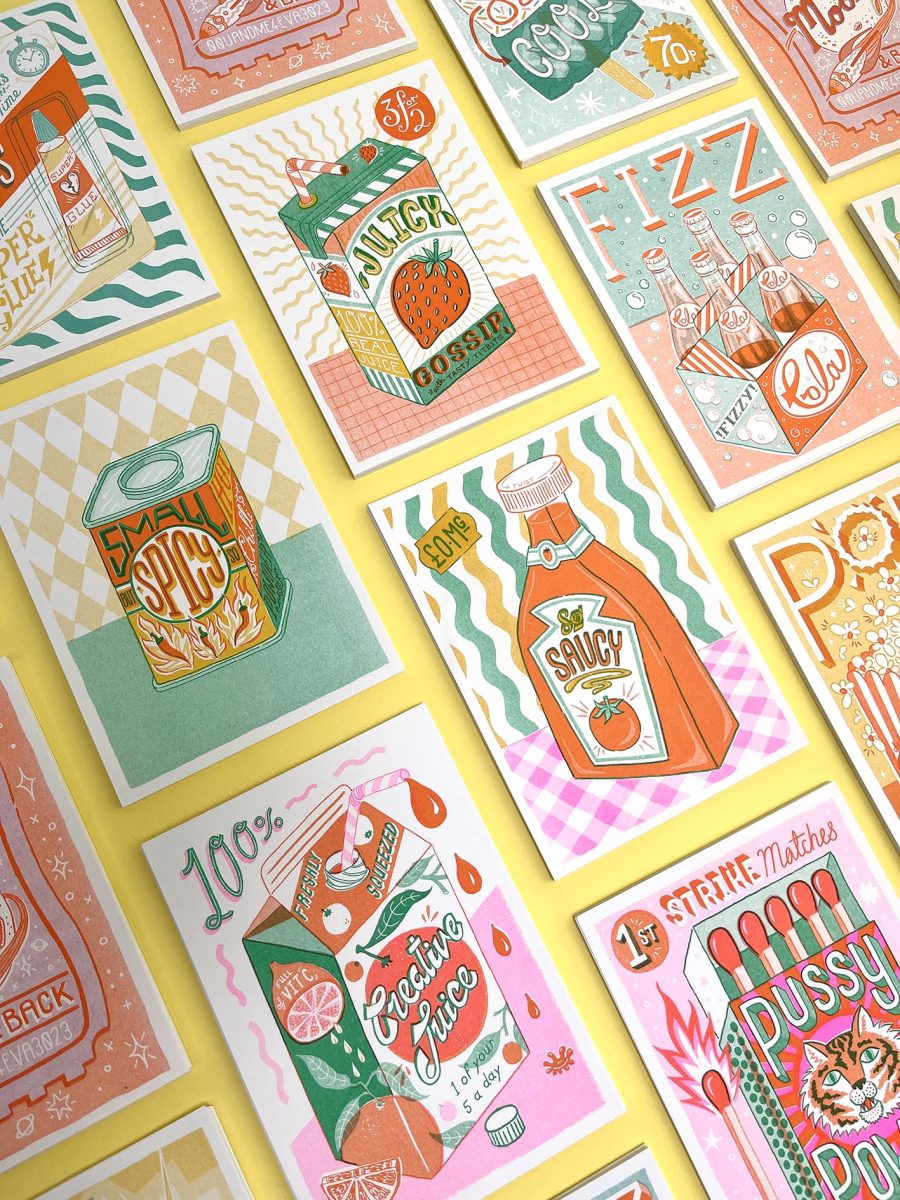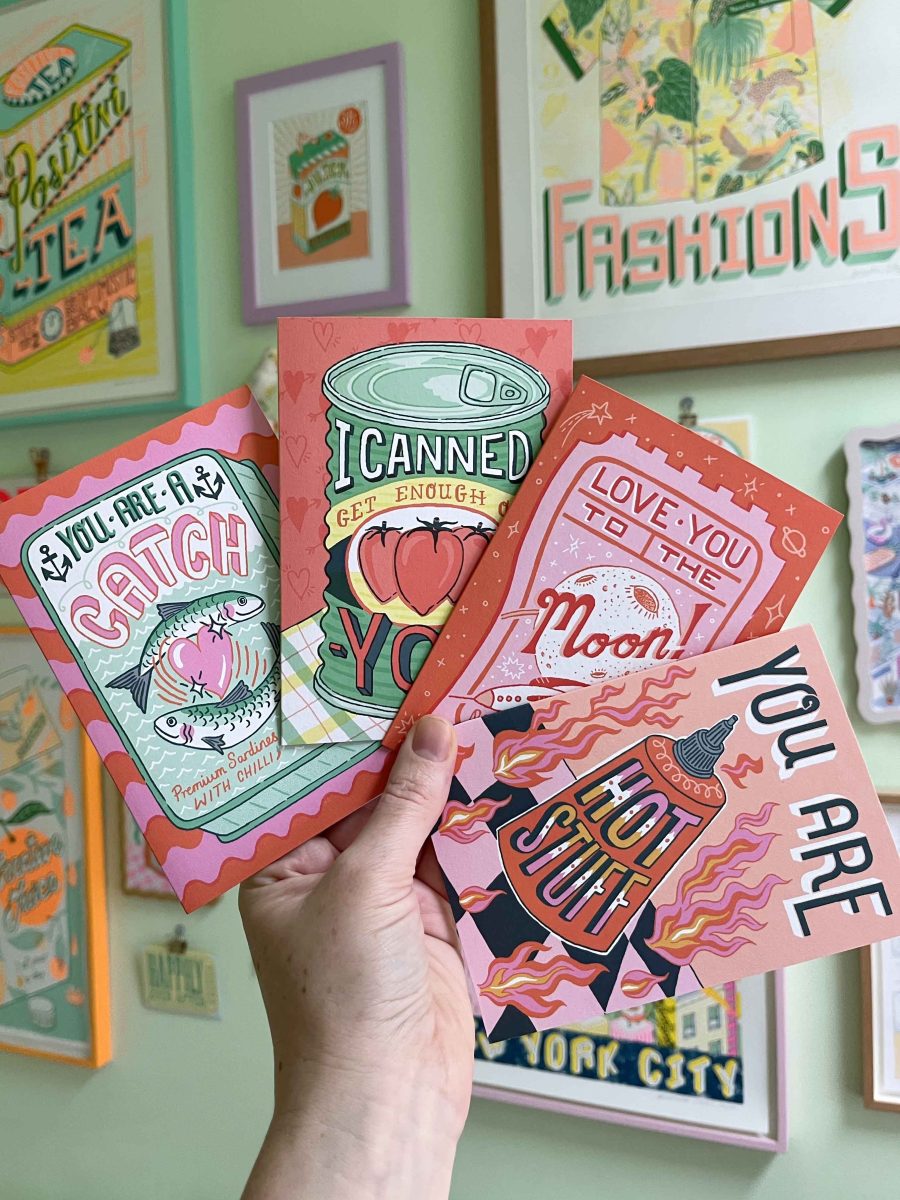How to Sell Your Artwork Online and IRL: Insights with Jacqueline Colley

Selling prints and products online and in real life can be a great additional income stream for illustrators; for some it even becomes the main focus of their practice. However, it can be tough to know how to get started!
We sat down with illustrator and pattern designer, Jacqueline Colley to ask her advice on running a successful online shop and in person events whilst also balancing illustration commissions. From ordering products to choosing a platform, Jacqueline shares her experiences and some valuable lessons she’s learnt along the way.
Can you tell us a bit about yourself and your illustration career journey so far?
So it’s been a winding path! I studied Graphic Design at Chelsea and graduated into the 2008 recession. After some uncertainty and half a year on the dole, I was lucky to get a graduate role at H&M designing pattern and placement prints for their children’s wear department. This was a brilliant learning experience, and the beginning of 6 years working in textile design. I got obsessed with repeat patterns and exploring textile archives, whilst working for several brands, before deciding that I wanted more creativity in my life and eventually taking the leap into freelance.
My original intent was to find more creative work, and that became a gradual transition into illustration. I’d always loved illustration but hadn’t had the confidence to pursue it, but then I started making and selling my own products; online and at creative markets in London to showcase my style and ideas. This began to lead to commission and collaboration requests that crossed over into the realm of illustration. Around this point I went to see the AOI give a talk at New Designers, which made me realise that illustration was the right fit for me. The talk armed me with lots of new ideas and approaches to being deliberate and direct about seeking out the type of work I was interested in.

Was there a key moment that made you think more seriously of yourself as a business?
A real turning point for me was when I had a few products with my designs on and I took part in a UAL graduates initiative to present my work at ‘Pulse’, a trade show that is now part of Top Drawer. There were several seminars in the lead up on topics like ‘pricing your work for wholesale’ and ‘using social media’; this was 2015 and I didn’t get what that was yet! The whole process was really eye opening. I exhibited with several other graduates and their fledgling businesses, as well as a whole trade show of inspiring stationers and small businesses. The experience made me see the possibilities within self-made work, wholesale and making a living from your illustrations. This is when my shop started to become one of my multiple income streams, though a trickle or drip at first!
Many illustrators are looking to diversify their income at the moment. How much of your work comes through client commissions and how much is product sales? Do you have any advice on trying to strike the right balance?
I think that striking a balance is almost impossible. When I’m working on my shop I feel guilty that I’m not seeking out fun illustration work, and vice versa! I’ve learned through my journey that I don’t have much control over how much commission work I get. I can also be very fussy about what I take on. If a project makes me feel excited I know that I want to work on it, but if it leaves me feeling nothing then I choose to pass. This is definitely a luxury fostered from having a steady income from my shop – which I really appreciate.
Covid really turned things upside down as I often work on product jobs that were paused or cancelled, and my online shop was a life saver. Normally around a third of my income would be through online sales, but in 2020 that spiked to over half – so a big chunk! For me it’s been a slow process to build up the shop, but it’s been worth it in the long run!

You have created load of lovely products, from prints to throws. Knowing what products to make and how many to produce can be really tricky. What’s was one lesson you’ve learned along the way, that could be helpful for other illustrators to know ?
I’ve definitely learned from my mistakes that you want to trial things out if possible, and always start with small quantities as investing in stock can be a risk. However, saying that, it’s an integral part of running a shop to invest in it and see what sells!
A couple of tips are to get feedback from socials or IRL market stalls; run a poll on designs or colour-ways, and gauge people’s interest. If you can make it yourself and trial it even better. I started off by getting several designs printed on lengths of cotton that I’d make into tea towels, lampshades and cushions to see what worked! If you find a manufacturer that requires large minimum order quantities then you can try negotiating them down, or get in contact with some independent shops you like with a line sheet to see if you can sell some of the stock wholesale. This will help you sell out and make a profit quicker.
I also think my biggest learning curve was taking part in IRL creative markets like Crafty Fox, Renegade and DIY Art Market. You will immediately see and hear what people like and don’t like. Frustratingly the popular things sell out first and you’re left with the slower items, but it’s great market research! Markets have become increasingly over subscribed and hard to get on to in recent years but it’s always worth applying, as a lot will rotate their stallholders for fairness and to keep things fresh for visitors. I’d suggest starting local as it will be cheaper and easier with less travel too.
A site like Peddle is a great resource for finding relevant events near you. I still like to do markets and now I’m interested in travelling further and trying new events to see if they work for me and find a new audience for my work. The slow demise of Social Media means IRL events have never felt more important, I’ll be at Endless Love Creative later this year which is a Northern market with a great reputation and I’m excited to see all the work there.
You sell your prints through several different websites, as well as on your own online shop. What are some important considerations for artists when picking an online selling platform?
I think it’s a good idea to figure out where your audience might be, and to know that building steady sales can take time. There are loads of drop ship website options out there, so it could be good to find something that is perfect for your niche; for example: if you make plant illustrations, there may be a plant website which could stock your work, and so on.
However I’ve found that some platforms have not worked for me at all, and I’ve chosen to move on. My advice would be to not spread yourself too thin, as uploading a new product when you have 4+ sites can be a lot of admin, so be selective.
I use my own website (which my socials point to) and Etsy as my two main platforms. I was on Etsy for years before I started to see regular sales come in, but now I love it as a platform that helps me find my audience. It’s worth using a platform like this with an existing audience, as selling from your own website relies on your marketing efforts and social media following. I chose to do both as it was important for me to have an integrated shop as part of my website, and web traffic is probably good for my SEO! I think it’s makes sense to start with just one platform and build from there.

You have a really engaged social media audience. Do you have any tips for how other illustrators can nurture and grow their following?
It’s so tricky. I feel like I fall in and out of love with Instagram on a weekly basis haha! I’m fortunate that I started using Instagram fairly early on, and often found that I built up followers from events like the House of Illustration fairs, or collaborating with fellow small creatives on products, and sharing our work with each other’s audience. Recently I’m finding that what works well for me is when I invite people behind the scenes in my stories, sharing what I’m working on in my studio; drawing, photographing the process etc. The problem is remembering to do this and making it part of your day, or more realistically week!
I love to chat and reply to comments as I really appreciate those, and I like using the app to connect with the wider illustration community (especially when we were stuck at home through Covid), so it’s definitely got it’s plus points!
Running your own business can feel like a lot of pressure sometimes. What do you to look after your wellbeing as a freelance creative?
So I describe myself as a creature of habit, as routine works really well for me. I work in a loose 9-5 structure and try to keep the weekends free for everything else (unless there is a crazy deadline). I also do the same tasks on the same day every week: on Tuesdays I pack orders, on Wednesdays I go to the post office, and so on; that helps me structure my week and identify where I’m at! It’s been harder during the pandemic as my fave ladies’ aerobics classes were closed, but again, doing a couple of the same exercise classes every week gives me routine, a little social hit, and some endorphins which helps out loads!

Can you share 3 tips for your peers who want to start selling their work online, but aren’t sure where to start?
1. I’d say that good clear photography is the key to selling your work online. You can either outsource it, or simply do it yourself; invest in a roll of white paper, continuous lighting and your phone camera, this probably more than good enough. This is the cheap set up that I use, along with some sheets of coloured card and some styling props! I take all my photos around midday, or when things are bright, and then do some cheeky adjustments in Photoshop. Good photos from every angle are your biggest tool to help sell your products online!
2. Start simple. Can you do small runs of lots of different ideas and see what works? Consider getting a small table at a market to try things out.
3. Don’t hesitate! The biggest barrier I see facing people is themselves. Your product and website do not need to be perfect before you can start selling, and maybe you are just finding reasons to get in your own way. Just make it and share it already!
Jacqueline Colley is a talented Illustrator and Pattern Designer based in East London. She specialises in creating explorable and playful illustrations that celebrate everything from fruit to everyday objects. Her impressive client list includes Hermes, Chilly’s Bottles, Twitter, Ohh Deer, Kate Spade, and Refinery29. Explore more of Jacqueline’s wonderful work:
Illustrations and Photographs © Jacqueline Colley
Back to News Page
